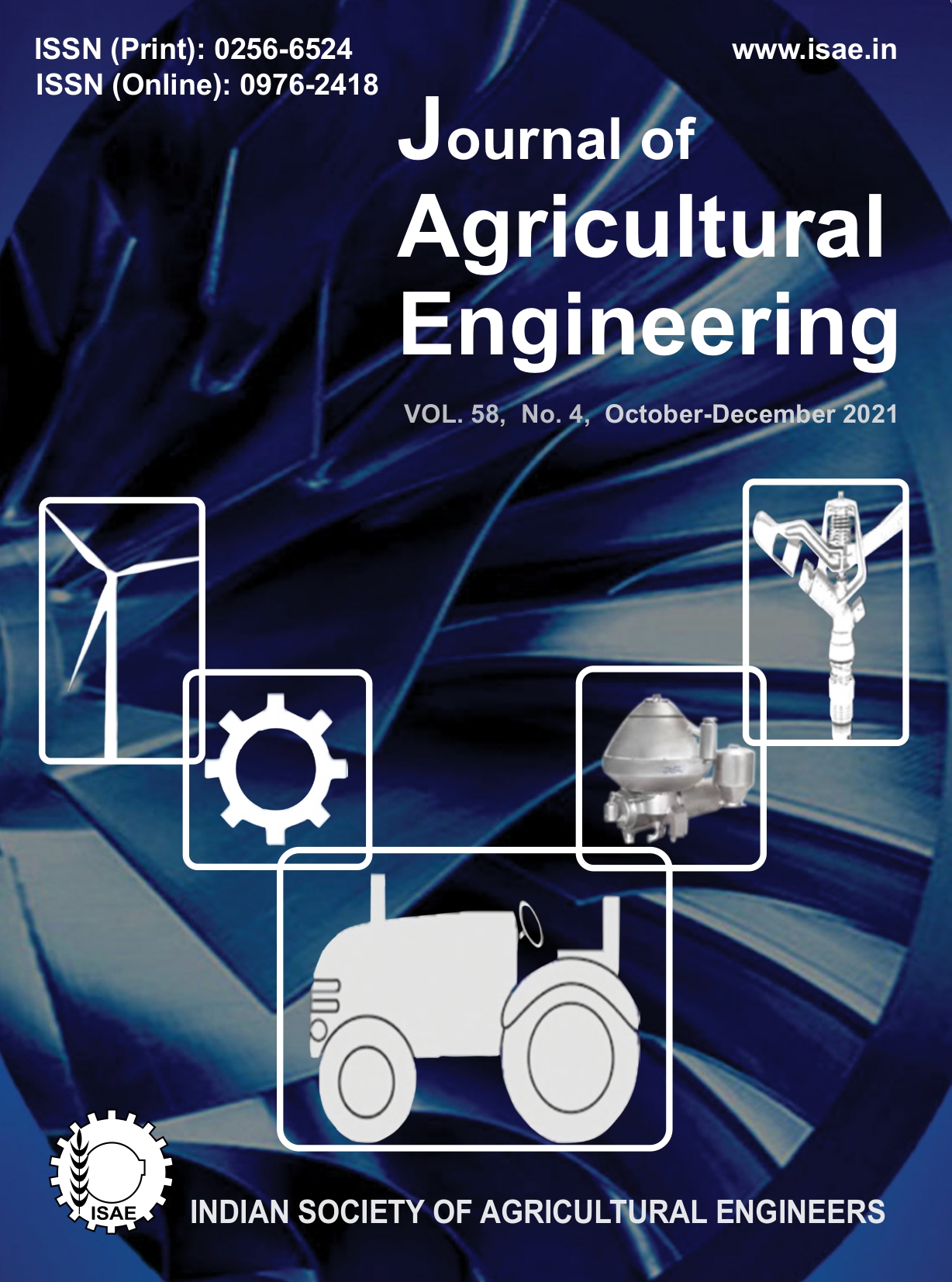Study on Tillage Quality and Energy Requirement of ‘L’ and ‘C’ Profile Rotary Tiller Blades for Clayey Soil of Sikkim under Soil Bin Condition
DOI:
https://doi.org/10.52151/jae2021581.1754Keywords:
Rotavator, soil mean mass diameter, energy requirement, blade profile, response surface methodologyAbstract
influencing the energy requirement and tillage quality of rotary tillers. In the present study, the operating parameters like blade profile, forward speed (Fs), rotary speed (Rs), and operating depth (Do) were optimized with respect to energy requirement (ER) and tillage quality in terms of soil mean mass diameter (SMMD). Twenty experiments for each blade with 3 replications as per experimental design obtained using response surface methodology were conducted under controlled conditions in a soil bin. It was observed that forward speed, rotary speed, and depth of operation significantly affected the tillage quality. The lowest SMMD (0.97 mm) was observed for ‘C’ profile blade at 1.5 km.h-1 Fs, 500 rpm Rs, and 80 mm Do. The minimum energy requirement (2,200.43 kJ.ha-1) was observed for ‘L’ shape blade at 1.5 km.h-1 Fs, 300 rpm Rs, and 80 mm Do. The effect of depth of operation was significant on energy requirement for both types of blades. The minimum energy requirement for both types of blades was at 1.5 km.h-1 Fs, 300 rpm Rs, and 80 mm Do. The optimum values of operating parameters for C-type blade were 1.2 km.h-1 Fs, 382 rpm Rs, and 66 mm Do correspond to SMMD of 0.97 mm and ER of 3813.7 kJ.ha-1. In case of L-type blade, the optimum values were 1.2 km.h-1 Fs, 320 rpm Rs, and 66 mm Do correspond to optimum SMMD of 1.03 mm and ER of 3414.2 kJ.ha-1.
References
Anon. 2021. Annual Progress Report 2020-21. Department of Agriculture, Govt. of Sikkim, Gangtok, Sikkim, 31-32.
Gautamary M V; Krishi V K; Rajvir Y. 2017. Design optimization of rotary tillage tool components proportionate to tractor power using computer software. Int. J. Appl. Agric. Hortic. Sci., 7(6), 1266-1518.
Jafar H; Surendra S. 2009. Optimization and evaluation of rotary tiller blades: Computer solution of mathematical relations. Soil Tillage Res., 106, 1-7.
Jain V K; Trivedi H K; Bhargav K S. 2017. Assessment of tillage operations on yield attributes of chickpea. Int. J. Agric. Sci., 9(6), 3816-3817.
Makange N R; Tiwari V K. 2015. Effect of horizontal and vertical axis rotavators on soil physical properties and energy requirement. Trends Biosci., 8(12), 3225- 3234.
Mandal S K; Bhattacharyya B; Mukherjee S. 2013. Design optimization of rotary tiller blades. Sci. J. Pure Appl. Sci., 2(6), 260-269.
Mandal S K; Bhattacharyya B; Mukherjee S; Prasad A K. 2016. Design optimization of rotary tiller blade using specific energy requirement. Int. J. Curr. Eng. Techno., 6(4), 1257-1263.
Matin A; John M F; Desbiolles; Jacky M A. 2014. Furrow parameters in rotary strip-tillage: Effects of blade geometry and rotary speed. Biosys. Eng., 118, 7-15.
Matin M A; Desbiolles J M A; Fielke J M. 2015. Strip-tillage using rotating straight blades: Effect of cutting-edge geometry on furrow parameters. Soil Tillage Res., 155, 271–279.
Mehta M L; Verma S R; Misra S K; Sharma V K. 2005. Testing and Evaluation of Agricultural Machinery. Daya Publishing House, Delhi, 65-66.
Niyamapa T; Thampatpong S; Rangdang C; Salokhe V M; Singh G. 1994. Laboratory investigation on design parameters of rotary tiller. In: Proc. Int. Agric. Eng. Conf. held at Bangkok, Thailand, 6-9 December, 206-214.
Nkakini S O; Vurasi N M. 2015. Effects of moisture content, bulk density and tractor forward speeds on energy requirement of disc plough. Int. J. Adv. Res. Eng. Technol., 6(7), 69-79.
Raigar R K; Mishra H N. 2021. Conduction roaster for accelerate roasting of peanut. J. Agric. Eng., 58(2), 112-123.
Rajesh A N.; Shridar B; Jesudas D; Manohar. 2018. Effect of rotary tiller blades on soil disintegration. Int. J. Agri. Eng., 11(1), 73-78.
Ramesh P; Sachin C; Ritesh M; Sunny B; Ankur S B. 2016. Performance evaluation of rotavator based on different soil moisture content. Int. J. Eng. Sci. Res. Technol., 5(8), 2277-9655.
Saha K P; Dushyant S; J Dilip; Singh K P. 2018. performance evaluation of tractor operated rotary assisted broad bed former-cum-seeder for wheat sowing. J. Agric. Eng., 55 (3), 1-11.
Salokhe V M; Hanif M; Makoto H. 1993. Effect of blade type on power requirement and puddling quality of a rotavator in wet clay soil. J. Terramech., 30(5), 337-350.
Srivastava A K; Goering C E; Rohrbach R P; Buckmaster D R. 2006. Engineering Principles of Agricultural Machines. ASAE Textbook No.6, American Society of Agricultural Engineers, 2950 Niles Road, St Joseph, Michigan, 211-214.
Summers J D; Khalilian A; Batchelder D G. 1986. Draft relationships for primary tillage in Oklahama soils. Trans. ASAE, 29(1), 37-39.
Walton P G; Warboys I B. 1986. An investigation into the power requirements of an experimental wye double digger. J. Agric. Eng. Res., 35 (4), 213-225.














